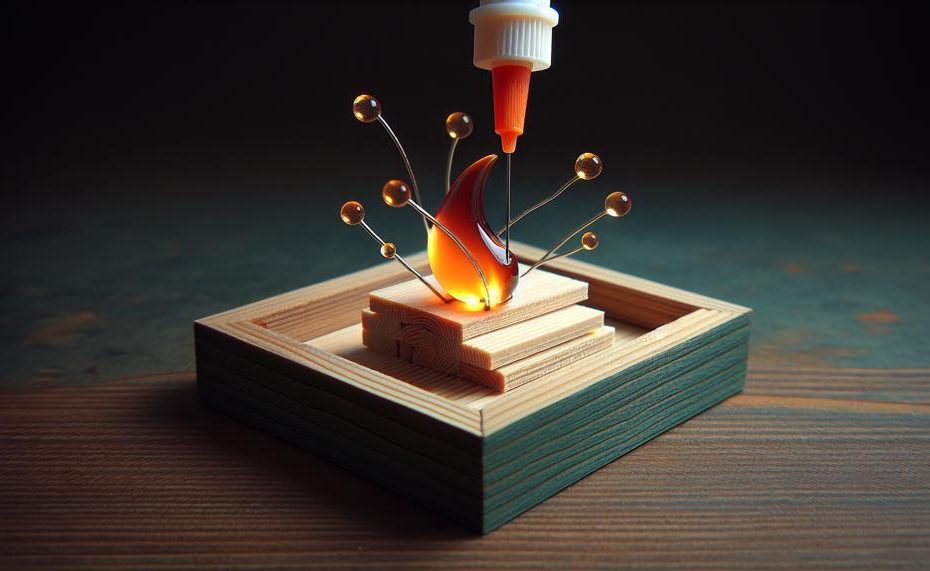Woodworking is a craft that requires precision, patience, and the right tools. And when it comes to bonding materials, hot glue is a go-to for many woodworkers. Its versatility and ease of use make it a popular choice for projects involving wood.
However, there are times when this trusty adhesive fails to stick to wood as expected, leading to frustration and setbacks.
So, does hot glue really stick to wood? In this blog post, we’ll delve into the world of hot glue and its relationship with wood. From the science behind its adhesion to common reasons for failure and tips for achieving a strong bond, we’ve got you covered.
Whether you’re an experienced woodworker or just starting out on your crafting journey, keep reading to discover everything you need to know about using hot glue on wood.
Let’s get started by exploring some key points:
- The fascinating chemistry behind hot glue’s bond with wood
- Common reasons why hot glue may not adhere properly
- How to properly prepare wood for successful hot glue application
- Alternative adhesives that can be used for bonding wood
- Insider tips for ensuring a strong and lasting bond between hot glue and wood
Table of Contents
- 1 What Is Hot Glue?
- 2 Does Hot Glue Stick to Wood?
- 3 Is Hot Glue Permanent?
- 4 Can You Use Hot Glue To Join Pieces of Wood?
- 5 But How Much Weight Can Hot Glue Carry When Used On Wood?
- 6 Hot Glue Used In The Woodworking Shop
- 7 Can Hot Glue Be Used To Support Wood Joints In Furniture?
- 8 Will It Peel Off The Wood I’ve Used It On?
- 9 The Glue In Our Own Woodworking Shop
- 10 Conclusion
What Is Hot Glue?
Hot glue sets itself apart from other types of adhesives due to its unique composition, method of application, and strength of bond. Unlike conventional wood glue, hot glue is not water-based and does not require clamping or drying time.
Its high viscosity makes it ideal for filling gaps and adhering to porous surfaces, such as wood. Additionally, hot glue is available in various melting points and can be used with different types of hot glue guns, making it a versatile adhesive for a wide range of applications.
One of the key advantages of hot glue is its ability to quickly solidify upon cooling, resulting in a strong bond that can hold lightweight projects together. This feature also enables it to be used for both temporary and permanent bonds on wood surfaces, making it an essential tool in woodworking projects. Its water-resistant properties also make it suitable for outdoor use in moderate climates.
However, when compared to traditional wood glue, hot glue may not provide as enduring of a bond for long-lasting projects. Additionally, it is not recommended for use on wet or rotting wood as its effectiveness may be reduced.
As a result, experts often recommend using a combination of hot glue and traditional wood glue for stronger bonding on wooden surfaces.
Does Hot Glue Stick to Wood?
Absolutely. Hot glue readily adheres to wood due to its thermoplastic properties. It melts when heated, allowing it to penetrate the wood’s surface, and then solidifies upon cooling, forming a strong bond. This makes hot glue an ideal choice for various woodcrafting and repair projects.
Several factors influence the effectiveness of the bond between hot glue and wood:
| Factor | Effect on Bond Strength |
| Wood type | Some woods, like oak and maple, have natural oils that can interfere with the glue’s adhesion. Sanding or roughening the surface before applying hot glue can help improve the bond. |
| Glue type | Different types of hot glue have varying strengths and compositions. Some are specifically formulated for wood, while others are more versatile and can be used on various materials. Choosing the right glue for your project is crucial for optimal adhesion. |
| Surface preparation | Ensure the wood surface is clean, dry, and free from dust, oil, or grease. A clean surface allows the glue to form a stronger bond with the wood. |
| Glue application | Apply a sufficient amount of hot glue to the wood surface to ensure proper adhesion. However, avoid using too much glue, as it can weaken the bond and create a messy appearance. |
| Clamping or pressure | Applying pressure to the glued joint while it cools helps improve the bond strength. Clamps or weights can be used to hold the pieces together until the glue has completely set. |
| Temperature and humidity | Hot glue works best at room temperature. Extreme temperatures or high humidity can affect the glue’s performance and weaken the bond. |
With proper technique and consideration of these factors, hot glue can be an effective adhesive for wood, providing a strong and long-lasting bond for various projects.
Is Hot Glue Permanent?
Hot glue may seem like a strong adhesive for certain applications, but it is not commonly considered a permanent option for wood. There are various factors to consider, such as the type of wood being used, surface preparation, and the intended purpose of the project before deciding to use hot glue for wood projects.
For example, softwoods like pine or cedar may not be the best choice for hot glue as they can easily split or crack under pressure. On the other hand, hardwoods like oak or maple are denser and can provide a stronger bond with hot glue.
Surface preparation is also crucial when using hot glue for wood. It is important to ensure that the surface is clean and free of any debris or oils that can prevent the glue from adhering properly. Sanding the surface can also help create a rougher texture for better adhesion.
Furthermore, it is important to consider the intended use of the project when using hot glue for wood.
If the project will be exposed to high levels of heat or moisture, hot glue may not be the best choice as it can soften or lose its grip in these conditions.
Can You Use Hot Glue To Join Pieces of Wood?
Unfortunately, hot glue is not the ideal choice when it comes to bonding pieces of wood together. This is due to its thermoplastic properties, which make it more prone to melting and losing its adhesive strength when exposed to high temperatures.
Additionally, hot glue does not penetrate deeply into the wood fibers, making it less effective at creating a strong bond. Its sheer strength is also weaker compared to other adhesives that are specifically designed for woodworking projects.
Thus, it is not the most durable or reliable option for joining pieces of wood together.
It’s important to keep in mind that using the wrong adhesive can result in weak or unstable joints, which can lead to issues later on.
So, when working with wood, always choose an appropriate adhesive that is specifically formulated for woodworking purposes. This will ensure that your projects are sturdy and long-lasting.
But How Much Weight Can Hot Glue Carry When Used On Wood?
When it comes to supporting heavy weights on wood, hot glue may not be the most reliable choice.
Although it can hold smaller and lighter objects, it does not have the same strength and durability as other adhesives specifically designed for woodworking projects.
It is crucial to consider the project’s weight and demands when selecting an adhesive and opt for a stronger option such as epoxy resin or construction glue if necessary.

| Adhesive Type | Strength | Suitable for Woodworking? |
| Hot Glue | Weaker | Not ideal for heavy weights or high-demand joints |
| Wood Glue | Stronger | Specifically designed for woodworking projects |
| Epoxy Resin | Strongest | Provides a strong and durable bond for heavy weights and high-demand joints |
| Construction Glue | Durable | Designed for strong connections in woodworking projects |
| Titebond | Durable | Ideal for both interior and exterior woodworking projects |
As shown in the table above, hot glue is not the most suitable adhesive for woodworking projects that require strong support.
While it may have some use in minor repairs or decorative items, it is not reliable for holding heavy weights. Instead, options such as epoxy resin and construction glue are better choices for providing a strong and long-lasting bond in high-demand joints.
Titebond is also a preferred option among woodworkers due to its versatility and ability to work in both interior and exterior projects.
Compared to hot glue, these adhesives have better penetration into wood fibers and can withstand more stress and weight without weakening.
They are specifically designed for woodworking projects and have been thoroughly tested and proven to provide strong and long-lasting bonds.
Hot Glue Used In The Woodworking Shop
Hot glue’s bond to wood in the woodworking shop is due to its unique composition, viscosity, and rapid solidification.
Its adhesive properties are activated when heated, causing it to become sticky and pliable, allowing it to seep into the pores of the wood and create a durable bond.
To better understand the intricacies of hot glue, let’s break down its components and their role in adhesion.
| Component | Function |
| Thermoplastic polymer | Activates hot glue’s adhesive properties when heated. |
| Wax | Makes hot glue more flexible and less prone to cracking. |
| Mobilizers | Increase the flow of the glue, allowing it to penetrate the porous surface of wood. |
| Tackifiers | Improve the stickiness and grip of hot glue. |
In addition to its unique composition, hot glue’s ability to solidify quickly is crucial for its bond with wood. As it cools, it forms a strong seal with the surface, creating a tight and durable bond.
However, hot glue may not be as effective on wet or decaying wood as the porosity is reduced, making it more challenging for the glue to penetrate and adhere.
Despite not being suitable for heavy loads or outdoor projects, hot glue remains a versatile and valuable adhesive in the woodworking shop. Its ability to seal porous surfaces and solidify rapidly makes it ideal for smaller tasks or bonding different materials together.
Some experts even recommend mixing epoxies and elastomers to create a stronger bonding hot glue for more demanding projects.
Can Hot Glue Be Used To Support Wood Joints In Furniture?
When it comes to using hot glue to reinforce wood joints in furniture, there are a few things to consider. While it can be a viable option, it may not always provide the strongest and most long-lasting results. To ensure success, it is crucial to select the right type of hot glue and properly prepare the surface before application.
Though hot glue can form robust bonds on both porous and non-porous surfaces, it may not be as durable as other types of wood glue in larger construction projects or heavy-duty applications. Moreover, due to its tendency to deteriorate over time, hot glue may not be the best choice for long-term use in furniture joints.
In certain situations, however, hot glue can be a useful support for wood joints in furniture. For example, if you are working with small pieces or delicate materials, hot glue can offer a quick and secure bond without causing any damage.
Additionally, it can also be an excellent solution for temporary fixes or minor repairs.
Will It Peel Off The Wood I’ve Used It On?
If you want to ensure that hot glue does not peel off the wood it is applied on, there are a few steps you can take.
Select the appropriate type of hot glue
Not all hot glue is created equal, and some may work better for wood than others. Look for a high strength or heavy duty hot glue specifically designed for bonding wood. This will result in a stronger and more durable bond.
Prepare the surface correctly
Before using hot glue, make sure the wood surface is clean and free of any dust or debris. This will allow the glue to adhere better and prevent peeling.
Use enough hot glue
It is crucial to use an adequate amount of hot glue to create a strong bond. Using too little can lead to weak areas that are more likely to peel off. Apply enough hot glue to cover the entire joint or area being bonded.
Allow the hot glue to fully dry
Hot glue requires time to completely dry and set in order to form a robust bond. Make sure to let it dry completely before handling or using the wood piece.
Consider additional reinforcement methods
If you are concerned about the strength of hot glue alone, consider reinforcing it with other methods such as screws or nails. This will provide added support and help prevent peeling.
In conclusion, selecting the right type of hot glue, properly preparing the surface, using enough glue, allowing it to fully dry, and considering additional reinforcement methods can all contribute to preventing hot glue from peeling off wood surfaces.

The Glue In Our Own Woodworking Shop
In the world of woodworking, hot glue is often the go-to temporary adhesive for smaller projects. Although it may not have the same strength as traditional wood glue, it still has its place in our own woodworking shop. However, when using hot glue on wood, it’s important to consider the type of wood being used.
Porous woods like pine, balsa, and cedar are the most compatible with hot glue. Their rough surface texture allows the hot glue to adhere more effectively compared to smoother woods such as maple or oak. This is because the rough surface provides more grip and creates a stronger bond.
Moreover, the porous nature of these woods allows the hot glue to seep into the pores, resulting in an even stronger bond. This makes hot glue an ideal choice for filling in cracks and imperfections in wood.
Furthermore, softer woods like pine are easier to work with when using hot glue.
Since hot glue dries quickly, working with softer woods ensures a faster bond and prevents any potential warping or bending due to the weight of the adhesive.
Conclusion
In conclusion, hot glue is a versatile and convenient adhesive for woodworking projects, thanks to its unique composition and quick solidification. However, it may not always provide the strongest and most durable bond for wood surfaces.
This is where factors such as wood type, joint type, weight support, safety precautions, and surface preparation come into play. These considerations are crucial in determining the effectiveness of hot glue in the woodworking shop.
While hot glue may not be suitable for heavy loads or permanent bonds on wood, it can still be a valuable tool when used correctly.
In our own woodworking shop, we have discovered that porous and softer woods are the most compatible with hot glue due to their ability to absorb the adhesive and create a stronger bond.
This makes hot glue a reliable option for projects that require a quick fix or temporary hold.






